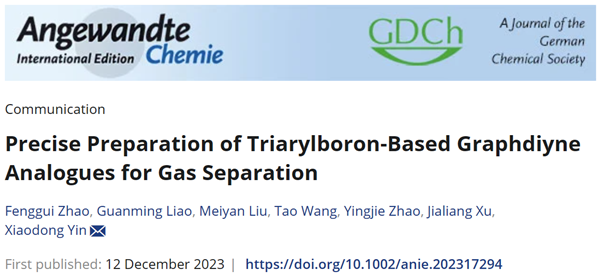BIT research group has made progress in the construction and application of boron-containing graphdiyne-like two-dimensional materials

Sponsored by

Sponsored by

Zhao Fenggui, a doctoral student from the School of Chemistry and Chemical Engineering of BIT (Beijing Institute of Technology), recently published a research paper entitled Precise Preparation of Triarylboron-Based Graphdiyne Analogues for Gas Separation as the first author in the top international journal Angewandte Chemie International Edition (DOI: 10.1002/anie.202317294). BIT is the first author affiliation for this paper, and Yin Xiaodong, a special researcher at the School of Chemistry and Chemical Engineering at BIT, is the corresponding author.
The separation processes in the chemical industry, including natural gas purification and gas separation processes such as oxygen and nitrogen production, are major contributors to energy consumption and carbon emissions. According to statistics, the energy consumed in these processes accounts for approximately 15percent of the world's total energy consumption. Compared with traditional separation methods such as distillation and adsorption, membrane separation is more energy-efficient. Therefore, the development of novel membrane materials with gas-selective separation properties has become a focus of attention.

Graphdiyne (GDY) is a new type of two-dimensional carbon group material, following diamond, fullerene, carbon nanotubes, and graphene, with a unique configuration of sp and sp2 hybrid carbon atoms. GDY has abundant carbon chemical bonds, large conjugated systems, porosity, excellent chemical and thermal stability, and is expected to become a new type of separation membrane material. Recently, Yin Xiaodong and his team constructed a series of two-dimensional materials with graphdiyne-like structures based on triarylboron monomers. They systematically studied the relationship between the boron-containing monomer structure, the pore size of the two-dimensional materials and the stacking structure, and preliminarily explored the potential applications in the field of gas separation.
Due to the 2s22p1 valence electron structure of boron atoms, neutral boron compounds (such as BF3) often adopt a planar sp2 hybrid configuration, which is conducive to the formation of a planar two-dimensional framework. Among them, triarylboron (TAB) has good chemical stability due to the kinetic protection of the aryl group, making it an excellent building block for constructing new planar two-dimensional materials.
The paper adopts a bottom-up approach to prepare TAB based graphdiyne-like two-dimensional structures (TAB-GDY) with adjustable pore size on the surface of copper foil through acetylene acetylene coupling reaction. A ultra-thin TAB-GDY film of about 4 nm was prepared by mechanical ultrasound method, and the selected area electron diffraction (SAED) showed a clear hexagonal symmetric pattern, proving the crystallinity of the TAB-GDY film. Based on the experimental SAED and DFT calculations of cell parameters, the establishment of stacking structures, and SAED simulation, it was determined that the TAB-GDY interlayer adopts a multiple stacking method.
The gas adsorption desorption experiment shows that TAB-GDY has a large specific surface area and rich microporous structure. In addition, due to the electron deficient nature of TAB groups and the electron rich nature of acetylene bonds, TAB-GDY exhibits certain IAST selectivity in binary gases. Among them, DPCEDMTAB-GDY has the highest selectivity for CO2/N2 and CO2/H2, with values of 21.8 and 41.9, respectively, followed by TMTAB-GDY, CEDMTAB-GDY, and DMTAB-GDY. In addition, the selectivity of the four TAB-GDYs for CO2/CH4 (3.1-5.3) and C2H2/CO2 (1.8-2.3) is similar.
This work combined the advantages of graphdiyne and triarylboron to develop a series of structurally clear and stable boron-containing two-dimensional frameworks. The adjustable pore size of these frameworks lays the foundation for future applications in the field of gas separation, further enriching the structural diversity and application areas of the graphdiyne-like materials family.
The above work has been supported by projects such as the National Natural Science Foundation of China. Thanks to the Analysis and Testing Center of BIT for their support in related testing.
Paper link: https://doi.org/10.1002/anie.202317294
About the author:
Yin Xiaodong is a doctoral supervisor from the School of Chemistry and Chemical Engineering of BIT. In 2011, he graduated from the Institute of Chemistry of the Chinese Academy of Sciences with a doctor's degree in organic chemistry and studied under academician Li Yuliang. Then, he worked as a postdoctoral researcher at Rutgers University, University of South Carolina, and Columbia University. He joined the School of Chemistry and Chemical Engineering of BIT in September 2018, mainly focusing on the development and application of organic boron functional materials. Up to now, he has published 70 SCI papers in internationally-renowned journals such as Nat. Chem., Sci. Adv., Angew. Chem. Int. Ed., and Adv. Mater., etc.